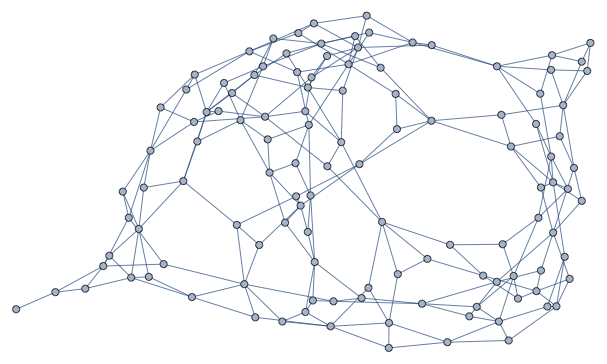Distribution of lengths of geodesics in the graph?
Distribution of lengths of geodesics in the graph?
Puff out each node to its neighborhood, then look at “renormalized” graph structure....
Puff out each node to its neighborhood, then look at “renormalized” graph structure....
In[]:=
gg=UndirectedGraph
Out[]=
In[]:=
VertexOutComponent[gg,#,2]&/@VertexList[gg]
Out[]=
In[]:=
Boole[Outer[IntersectingQ,%4,%4,1]]
In[]:=
AdjacencyGraph[%10]
Out[]=
In[]:=
SimpleGraph[%12]
Out[]=
Want to reduce all complete graphs to single vertices......
Want to reduce all complete graphs to single vertices......
Look at geodesics in graph
Look at geodesics in graph
Try to understand density of geodesics
Try to understand density of geodesics
Given a geodesic, what other geodesics are within certain distances of it?
Generalization for lines of question of volumes of balls....
As a function of geodesic distance along a line, how many points does one reach by puffing out a ball of a certain radius?
How does the density of nearby geodesics interact with the notion of curvature? What is the tradeoff between dimension and curvature for geodesic deviation?
Given two balls of nearby points, how many geodesics are there between them? And what is the volume of the bundle of rays that join the balls? As a function of the geodesic distance, look at the size (and shape/curvature) of the cross-section.
Consider decorating the network to look at propagation on the network independent of network change
Consider decorating the network to look at propagation on the network independent of network change
Assume that the network rewrite is e.g. just a sorting rule, so the structure does not change
CAs and particles on networks???? E.g. samosa network.......... What about actual network rewrites on it?
CAs and particles on networks???? E.g. samosa network.......... What about actual network rewrites on it?
Stable subgraph structures?
Stable subgraph structures?




